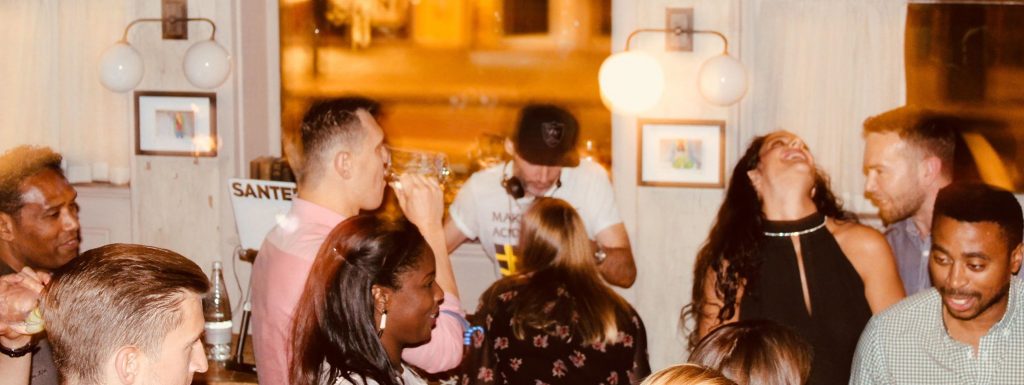
Back In The Booth!
Well, this has been a pretty insane year for the DJ community. And we are far from over it all yet – if we have learned anything this last year or so, its that you should never take anything for granted, even if you have it booked in your diary. Events can spiral very rapidly.
All that being said – if you are used to being a working DJ, now is a good time to take stock of a few things, prepare yourself mentally and physically, and make sure that you are well placed to get straight back to it.
I’ve been gigging hard since the UK’s most recent lockdown ended, so here’s a few hints and tips to help you get back to work safely and effectively!
Health & Safety
This probably doesn’t need pointing out, but we aren’t out of the woods yet with this pandemic, so take a mask with you to wear at the appropriate moments, take some hand sanitiser, exercise caution in enclosed spaces with other people, such as elevators or stairwells etc.
If you can get ventilation to wherever you are DJing (by opening a door/window for instance) then do so – it massively helps reduce the risk of transmission of the virus if there is good airflow.
DON’T GO IN TO WORK IF YOU THINK YOU MIGHT BE SICK! I know it would suck to miss a gig right now, after so long, but it would suck a lot more to give all your co-workers the virus.
Music Library
This is a big one. A year of barely playing out to an audience can do interesting and strange things to your crates… You might have been active on Twitch – but its often a totally different thing on there compared to the “real world” (I certainly play quite differently on Twitch to how I do at live gigs, much more rarities and obscure stuff).
Playing to in-person crowds who are paying to be there (either through entry charges or the food & drink they are buying) can be very different to playing for people on the other end of an internet cable! Keeping a dancefloor happy is very different to keeping a chat room happy!
Some of you may have been following the charts and trends and new releases for your styles for the whole of the last year, and to those conscientious DJs – kudos! To those who haven’t, here’s a few ideas for ways to freshen up your crates.
And also think about your actual arrangement of your music library – we covered this topic here. Having well organised music is practically a super power for the modern DJ!
If you use USB sticks – get on to Rekordbox ASAP and get those sticks updated. Nobody enjoys that last minute rush on a gig night, wishing it would transfer the songs faster!
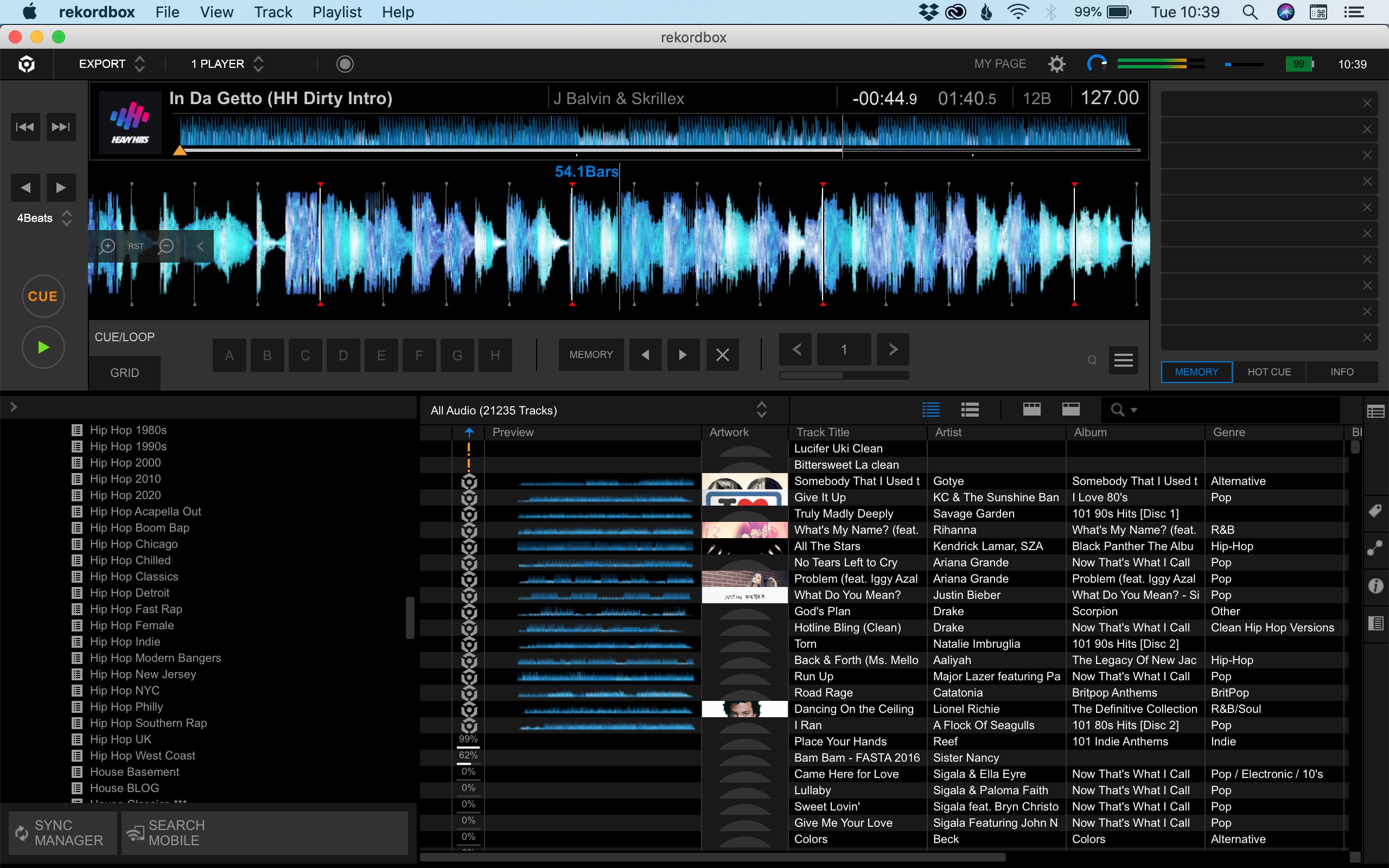
Equipment
Make sure everything that you need to use still works! Make sure you still have your adapters, your cables, your laptop stand – whatever it is you normally take, make sure you still have it, make sure it still works, and make sure you actually take it to your gigs!
On this last point – its not a bad idea to have some sort of checklist of crucial items, either written down, or that you call out to yourself while checking your bag, both when setting off to go to your gigs, and when packed up and about to go home at the end of the night. I always unzip the top of my rucksack and say out loud “laptop, stand, power cable, headhones, USB cable, USB sticks, earplugs” while checking all those items are there. There are other things in the bag, but those 7 are the real essentials.
Stamina
If you get booked to do long sets and haven’t been doing them at home for the last year, now is the time to start practising a few times before you get back out there!
Just getting used to being on your feet for extended periods of time is important, maybe sidestepping any possible posture issues you might get if your first gig is your first time stood at the decks for 5 hours at a time – your back might not be ready if you haven’t done a few warm up sets! Think about the shoes you have available for these gigs, if its a long one your feet will thank you to take care of them.
Another thing is the adjustment to finishing at times beyond midnight – I can say with certainty that this will be a shock to my system after a year of going to be at “Regular People” times!
Maybe pack some snacks and an energy drink or two if you aren’t sure how you’ll cope if you’re going to have to stay up later than normal – we covered the DJ love affair with snacking here.
Admin
Unglamourous, but necessary. Unless you have are the kind of DJ that has a team of staff doing this stuff for you, you need to think about the logistics of your gigs, and getting paid.
Promotional posts on your social media are practically a necessity these days, for multiple reasons – to advertise the event to potential customers, to show your teamwork to the people who booked you, and to let others know that you are out there spinning again.
Invoicing is essential if you want to get paid – make sure all your details are up to date on your invoice, and those of the venues you are DJing at. Last thing you want is for the money to go to an old account or for a payment to be held up for weeks because you invoiced to the incorrect business address or something.
Get your calendar skills back in tune, and maybe set reminders in your phone for the day before gigs – its not easy to immediately get back into the swing of things and remember everything without some external help, and you DEFINITELY do not want to be missing gigs out of forgetfulness!
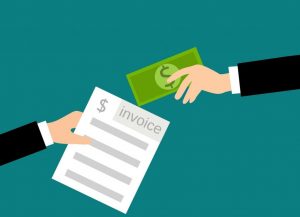
Social Media
I mentioned social media above – well, now is a good time to make sure that your Instagram (or whatever else you use) looks the part. Lets say you go out to your first gig and absolutely crush it. Somebody in the audience asks for your insta, and it just so happens that they do the bookings for a big venue across town – you want to make sure that you make a good impression when they look you up.
I know a lot of people don’t like the importance of social media in how people interact with DJs these days, but its a reality – most people will take a look at those pages before deciding whether to book a DJ. So it makes sense to work on your presentation as we get ready to go back into clubs and events.
Transport
If you drive to gigs – check that the routes and parking are the way your need them to be (lots of authorities are using this time to fix roads/bridge, or have changed access to certain streets/areas), and if they aren’t, make alternative plans. Its a lot easier to plan these things a week ahead of time rather than 30 minutes before your first set in a year is due to start!
If you use public transport – make sure your preferred methods are still running. Similar reasons (authorities fixing train tracks during a relatively quiet time for transit for example), and also some transport services may have seen budget cuts because of the squeezed finances caused by the last year or so. Better to know in advance and plan than turn up to your train station and be hit by a difficult surprise!
Mindset
I suspect that this will be a really big one for a lot of DJs. One of the reasons humans have done so well as a species is that we adapt so quickly to changing circumstances, and that becomes “normal” very fast.
And now, after over a year of acclimatising to a new way of doing things, we are about to be thrust back into the arena. And it might be even MORE crazy than before – people have been locked away for a year, and are absoluting itching to party!
This present a whole lot of opportunity for DJs, but don’t forget – drunk customers are often quite, how can we put it… “direct”.
I had my first run in with this the other night – playing at a venue that draws quite a latin crowd, but isn’t specifically for latin music. I had already played a bunch of latin house and reggaeton, and had moved on to a bit of disco and disco house. A table sat down, and within 5 minutes a woman comes over, and starts saying “when are you playing latin music, we booked here for my friends birthday because this is a latin place…” etc etc. I quickly reassured her to not worry, I would be playing latin music. Problem solved! Except, in classic requester style she then went and added “Because all you are playing is this 80s rubbish”.
I don’t know why people do this (make a perfectly normal request, get a positive answer, but then throw an insult on the end of the request), but it happens – it was the first time I’d had anything like this in probably over a year! I smiled, took a deep breath, and let her walk away. What I was playing wasn’t 80s, she’d only been in the venue 5-10 minutes, there is ABSOLUTELY NO POINT getting into it with her. Had she not come over, I would have played more latin music that night, so I played more latin music that night – much as it was tempting to say “NO LATIN MUSIC FOR YOU!”
The point of that anecdote is this – don’t let an idiot or two throw you off your game. Shrug them off, and keep pleasing the crowd as a whole. If they say something particularly stupid to you, make a note of it – it’ll make a funny tweet later on, and you might get some nice social media engagement out of it!
You’ll have to adjust to strange sleeping patterns, maybe your eating schedule and habits will be impacted. You’ll have the highs of great nights, and the lows of stinkers. Think about how this might affect your mood, other corners of your life, your responsibilities to others in your life (partners, family, housemates etc). Be prepared for the fact that your life is about to change back to a quite different pattern. But most of all – have fun, and be thankful that you get to do this amazing thing called DJing!
In the meantime, head over to the Heavy Hits record pool to check out the best music online, and head over to our socials at Instagram, Facebook and Twitter.

Classic Mixes
DJing is largely a performance role. The vast majority of most DJs make their reputations from the gigs they do, and the performances they give to live audiences.
But one crucial aspect of building a DJ reputation is to create mixes, and every so often a DJ drops a true classic, maybe catapulting them to greater heights, maybe cementing their status at the top table, often setting a trend that other DJs follow.
So, lets take a look at a selection of truly legendary mixes!
DJ Q-Bert – Demolition Pumpkin Squeeze Musik (1994)
If you are into scratch DJs, then you know all about Q-Bert – arguably the greatest scratch DJ ever to do it! On this mix he cut and scratched and juggled his way through the legendary Ultimate Breaks & Beats compilation record, the root of so many hip-hop samples! With assistance from Shortkut and DJ Disk, Q-Bert takes the listener on an immaculately compiled and technically insane journey through the heritage of rap music. This came out a year before Q-Bert invented the crab scratch, and some of the cuts will blow your mind! Its hard to explain just how far ahead of other scratch DJs Q was at this moment in time – like an alien from another planet.
Kaytranada – Boiler Room Montreal (2013)
Those few people who didn’t know about Kaytranada are about to find out about him, as he walked away from the 2021 Grammy Awards with 2 gongs! He’s been producing dynamite originals and remixes for about a decade now, and in 2013 provided the world with one of the most meme-able DJ sets of all time, his stunning 42 minute Boiler Room. Its a genuinely brilliant DJ set, perfectly encapsulatingly his swaggering, swaying, supercool style. But its also full of laugh-out-loud moments, courtesy of an incredibly enthusiastic (and lit!) crowd.
Caspa & Rusko – FABRICLIVE.37 (2007)
Caspa & Rusko were at the heart of the dubstep movement, and also were at the forefront of the more energetic and wobbly direction that took the USA by storm. FABRICLIVE mixes are a staple of the underground dance music scene, and every so often they catch an act just before what they do goes supernova – this is a case in point. Without these DJs, and without this mix, who knows if Skrillex happens, if EDM takes the form it did, and so on – this was a real landmark turning point for the dubstep genre (and not one that all dubstep fans ended up being too happy about in the end!).
Danny Tenaglia – Global Underground 010 Athens (1999)
Danny Tenaglia is a true legend of dance music. From humble beginnings in a 1980s Florida roller-disco, to being one of the biggest DJs in the world from his home in New York, Tenaglia has carved out a sound he terms “hard & soul” – deep, dark underground beats, matched with soulful vocals and instrumentation, often weaving between them in sets spanning 10+ hours. The Global Underground series spawned many contenders for “legendary” status, but this is the one that stands out for me, showcasing his mastery of tension, mood and atmosphere, while always keeping the dancefloor moving.
DJ Spinbad – 80s Megamix Vol 2 (2000)
Spinbad sadly passed away recently, which we covered here. He was legendary as a master of the DJ mix, and his pinnacle might be surprising to those who remember him as the exceptional hip-hop DJ he was. His 80s Megamix Vol 2 took the 80s megamix concept he’d developed, and ran with it to create a work of art – legendary pop and rock, interspersed with superb scratching and perfectly placed film soundbites, sometimes even mixing in vocals from movie scenes with matching songs! Several DJs have remarked on how they felt that this mix gave them “permission” to explore pop in a way they felt they weren’t supposed to beforehand – it certainly played a big part in the development of the open-format DJ as we know it today.
DJ Yoda – How To Cut & Paste Vol 1 (2001)
DJ Yoda is an old friend of the blog, having been interviewed here. He’s also a master of the mixtape, at one point laying down his own 80s megamix (but from a British perspective) after seeking permission from Spinbad (he didn’t want to seem to be jacking his idea!). He has many highlights in his mixtape reel, but this is a standout, and one that really helped him establish his approach. Inventive, witty, musically fantastic, anarchic, this set the tone for Yoda’s career, with one foot firmly planted in independent hip-hop, the other in sketch comedy of some sort! Endlessly entertaining.
Daft Punk – Essential Mix (1997)
Daft Punk have officially called it quits, and it was probably the right time – they’ve moved a long way away from the sound that they captured on this Essential Mix (the long-running and legendary BBC Radio 1 mix show), and ended up at some sort of smooth jazz thing – not that I disliked it, but it was a long, long way away from the Daft Punk I fell in love with – I actually saw them live in 1997 at Tribal Gathering! Disco-tinged, but full of oomph, and with a real edge to it – this mix is what I think of when I think of Daft Punk!
DJ EZ – Boiler Room x RBMA London (2012)
If you ask a DJ today to describe the most exhilirating drop ever caught on video, a lot of us will point to that mix by DJ EZ. You know the one… don’t you? Well, watch the 30 seconds above and you will. EZ is the king of UK Garage – and he’s a machine, in recent years doing multiple 24-hour sets for charity. The whole mix is worth checking out, as is any mix by this absolute legend.
Diplo – Essential Mix (2007)
What a career Diplo has had – now undisputably one of the biggest DJs in the world, and the man behind an enormous number of hit records, as Diplo, Major Lazer, or behind the scenes. This isn’t quite a “back when it started” mix, but its not far off, from around when he was just starting to blow up, and it showcases his genre-bending, crate-digging style brilliantly – what I would give for him to go back to this!
J-Rocc – Live At The Sex Machine (1999)
This one is a masterclass in live hip-hop mixing from one of the slickest DJs in the game, J-Rocc. Recorded live at the Sex Machine (hence the name), this is an immaculately selected and mixed collection of music from a very special point in time in hip-hop’s journey. J-Rocc has an uncanny knack for smooth, flowing mixes, and some of his trick mixing is so neat and tidy you can easily miss it! He’s one of my absolute favourite DJs, and is always worth listening to!
2ManyDJs – As Heard On Radio Soulwax Vol 2 (2003)
Released in 2003, this was hugely influential on DJs around the world, and much like the Spinbad mix mentioned above, it massively de-stigmatised using well known pop and rock records – something which had been viewed quite snobbishly for a long time. This heralded the start of the explosion in mashups in the mid 2000s, which was helped along by the likes of Erol Alkan and Diplo, and their popular internet forums. 2ManyDJs are also known as Soulwax, and continue to enjoy success to this day.
Coldcut – Journeys By DJ : 70 Minutes of Madness (1995)
Arguably the king of them all, this masterpiece by the founders of Ninja Tune Records covers a LOT of ground, and is often #1 in round-ups of the greatest DJ mixes of all time. Taking in rip-roaring jungle, hip-hop, techno, breakbeat, funk, ambient and more, this “drunken stagger home” of a mix (as one of the creators dubbed it) is one for the ages.
As you can see, these mixes cover a lot of musical ground – and there’s so many DJs I could have easily included, from Funkmaster Flex to DJ Shadow to Four Tet to Jazzy Jeff and so on.
The thing that links all these mixes – they are FULL of the personality of their creators, they don’t just rinse the same old tracks as everyone else, and they often surprise with the way they combine tracks and styles.
So – get yourself over to the Heavy Hits pool, and start assembling YOUR masterpiece!
Go follow Heavy Hits on Facebook, Instagram and Twitter. And you can check me out streaming on Twitch or over on Instagram.
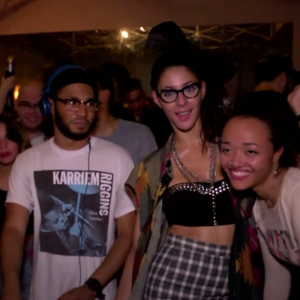
One For The Lovers (and One For The Ex’s!)
A few years ago, I read something that stuck with me. Emynd, badass DJ/producer out of Philadelphia, made a comment along the lines of how his job as a DJ was to provide the soundtrack for people to hook up to. I can’t remember if it was a specific event or genre he meant, or whatever, but anyway… It has stayed with me ever since, because the truth of the matter is that a LOT of the people on any given dancefloor are looking for that special someone. If a lot of people are hooking up at the end of your sets, you are probably doing something right.
Things are obviously a little different right now – but that doesn’t mean we can’t set the tone for some domestic loving with all the couples that will be having valentines dates at home this year! And maybe we can even help a few flatmates fall in love!
As always, the Heavy Hits pool has your back – we’ve got this phenomenal Valentine’s Day Lovers playlist to get people all touchy-feely, and maybe even a bit smoochy. Timeless classics from yesteryear, modern slow-jams, and lottttttts of baby-makin’ music!
But of course, not everybody likes this time of year. And Heavy Hits appreciates that some DJs just like to zag when everyone else zigs. Maybe what you want in your mixes, what you want on your streams, is anti-Valentine’s music. Ask, and ye shall receive! A collection of classics about cheaters, breakups, gold diggers and betrayal – perfect if you want to go against the grain for Valentine’s this year! Check that playlist out here.
One of the best features of Heavy Hits is the brilliant curated playlists, with music to cater for any occasion – go check the rest of our amazing playlists out here, and make sure you have the advantage over the DJs out there who don’t have access to this awesome resource!
And make sure you check out our amazing Instagram page here and Facebook page here, and if you’re on Twitter give us a follow there too!

Translating Twitch
One of THE trends of the last year has been the explosion of DJs using Twitch, the livestreaming service. Largely used by gamers, DJs have adopted it as the next-best-thing while clubs are closed, and it has generated a whole new ecosystem. Recently, I watched Skratch Bastid tear it up on the Serato channel to over 8000 viewers! Whole communitites have sprung around particular DJs and their channels, and performers from around the world have linked up in order to create virtual concerts (usually via “raiding” – more on that in a minute!).
But it can be a bit intimidating to the newcomer. I myself am just starting out my own twitch channel, and trying to work things out, so here’s a few basics to help you – both as a viewer, and as a creator!
Chat
Pretty self-explanatory really – there’s a chat window that you can chat in, where you can tag other viewers or the performer, the performer can chat in there as well. Expect to see a LOT of emotes, often including channel-specific ones. One of the features that subscribing to different channels provides is opening up the emotes from them – that’s why you will often see emotes that you can’t post yourself! In popular channels the chat can move incredibly fast, and be hard to follow at times!
Often streamers will have a set of rules that flash up and have to be agreed on before you enter the chat for the first time – its generally pretty standard stuff, be polite, friendly, etc. Play nice, basically! I’ve found Twitch chats on DJ streams to be very positive, friendly places.
It is possible for streamers to set chat to follower-only, or even subscriber-only.
Emotes
You’ve heard of emojis, and emotes are simply the Twitch take on this. There’s a bunch of standard global emotes available, and then you get more when you subscribe to channels at different tiers. Streamers can create their own emotes once they become affiliates (which is unlocked by fulfilling a few relatively simple streaming requirements), and the better they are, the more likely people are to subscribe to your channel! More on this very shortly, here’s a screencap of DJ Volatile’s channel, you can see some of the emotes he created here in the chat. You can also see different badges that users have, before their names in the chat.
Emotes are not limited to the channel where you get them – if you subscribe to Volatile, you can then use his emotes in other chats around Twitch – so if you are making them, think about ways to make cool emotes which will be used elsewhere and might incentivise people to subscribe to you in order to have use of them as well.
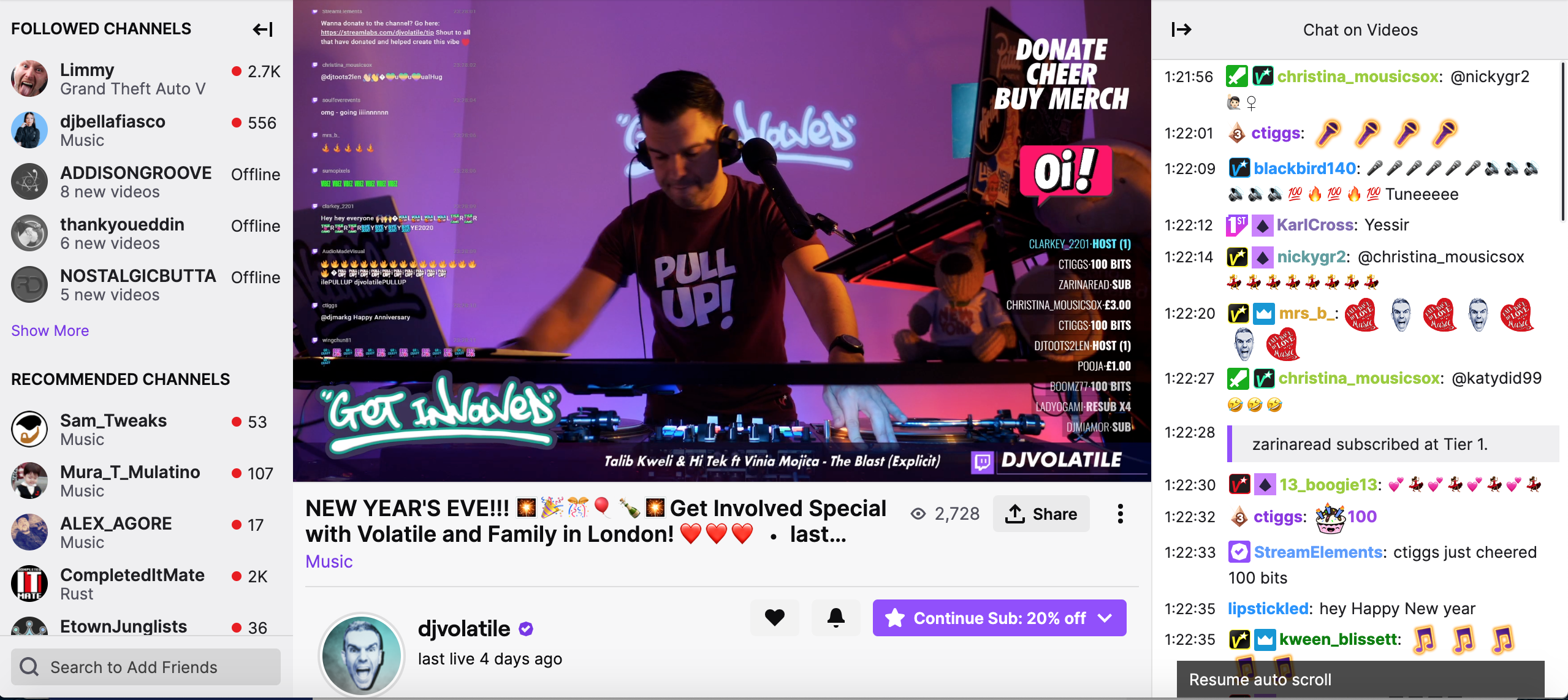
Badges
In the chat, names pop up, but also whatever relevant badges relate to the chat participant – follower, subscriber, how long you’ve subscribed, etc etc. Its a way of highlighting the most supportive and loyal fans in any given chat. More details here.
Follow
When you follow an account, it will add it to your follow list, and display that channel on the front page of your Twitch page when they are live. Its a good way to see when your favourite channels are active. It is completely free.
Notifications
If you click on the little notification bell on a channel you follow you toggle notifications on or off. You can set up notifications so that you get a message to your email inbox and so on – its quite customisable.
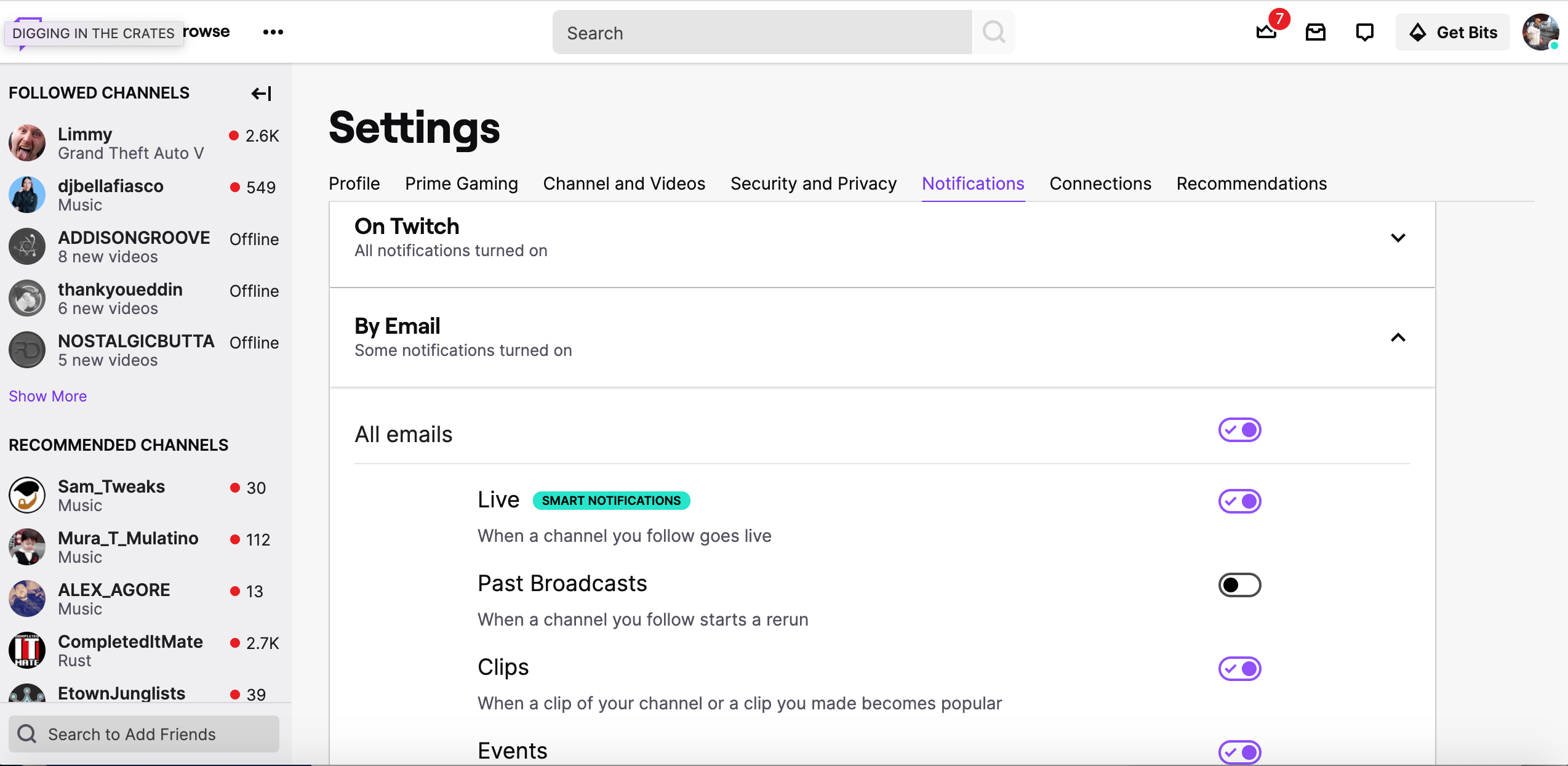
Subscriptions
Subscriptions are the next level on from following someone, and is essentially a monthly subscription to a channel. As I understand it – half the money goes to Twitch, half to the channel. This is a recurring monthly fee, and unlocks that channels emotes. People can buy them for themselves, and also you can gift them to other people if you want, or they can gift them to you. It also prevents you having to watch adverts each time you go to a new stream – if I hear that damn Tiesto advert another time, I might have to just subscribe to every channel on the entirety of Twitch…
It is worth noting that if you have Amazon Prime, you are entitled to one free Twitch subscription per month, as explained here.
Tiers
Tiers! UK readers will recoil in horror at that word, but in Twitch it just refers to the level of subscription you have. Almost everyone who subscribes goes for tier 1. Tier one costs $4.99, Tier 2 $9.99, Tier 3 $24.99. The most obvious difference you get access to even more emotes, and different badges for when involved in the chat, to show your loyalty to the channel. You also get emote modifier filters, which enable you to stand out further in the chat. Essentially, follows, subscriptions and tiers are all ways to support your favourite channels, and stand out a bit from other followers and subscribers if you really want to make your support known.
Channel Points
This is a points program for streamers to reward members of their community with perks, outlined in detail here. They are customsisable, and available to any affiliate or partner streamers. Essentially, its a loyalty system – it can be set up to reward watching, following, participating in raids, and so on. Speaking of which…
Raids
So, you may have heard about raids – they are one of the big selling points of Twitch as a platform. People set up “Raid Train” parties, and there’s even things like “Stream Raiders” as established events featuring DJs like DJ Yoda and Skratch Bastid.
Essentially, a raid is when the people watching a DJ are taken over into a new DJs stream. The initial DJ enters the command “/raid @nextDJname” into the chat, and Twitch does the rest. Its really fun, and a great way to direct your audience to other DJs you like and respect. And of course, others can come raid you and bring their crowds along as potential new fans!
Little bit of etiquette here – its generally not considered good form to outright ask people to raid your channel, unless it is someone you have the right relationship with, either personally or professionally. I’ve heard about people who’ve not texted a DJ in a year suddenly messaging “Hey, can you raid me after your set tonight?” out of the blue – NOT COOL! My personal rule is simply not to ask, and to raid people I think deserve it or who I’ve arranged it with as a reciprocal thing.
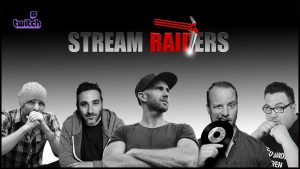
Bits
Bits are basically a Twitch currency – you buy them from Twitch at a fixed rate, and then can use them to “cheer” during broadcasts, and some of the money ends up with the streamer. Much like subscriptions, they function as a way of supporting a channel, of showing that support publicly, and differentiating you from other viewers. Streamers can set up visual and sound effects to be triggered when bits are spent – for instance, DJP has the Little Britain “bitty” sound clip set up to play whenever bits are given, which can extremely entertaining if timed right!
Hype Train
A hype train starts when a certain amount of paid activity happens in a 30 second window – subscriptions, cheers etc. Once it kicks off, a graphic comes up with a progress bar leading to the next level of the hype train. If more people subscribe or cheer etc within a specified window of time, the hype train grows. If not it tops out wherever it tops out. Generally speaking, once a hype train starts, viewers are far more likely to spend money on subs and so on.
Bots
This is something that you might be a bit cautious of, with social media “bots” often being assumed to be negative trouble-causers, but on Twitch the chat-bots are a brilliant labour-saving tool. You can instal a chat-bot, and then come up with simple commands which trigger the bot to say a pre-written comment. So, for instance, you could enter “!Twitter” and the chat-bot might automatically say “Go and follow DJ Funkybuns on Twitter, and be notified whenever he goes live on Twitch!”, or anything else you might want to say. Its up to you whether only you can trigger these command, or you + moderators, or anyone who wants to.
You can set certain commands to be on a timer, so that they are posted every 15 minutes or whatever. You can include a rule that they will only post if there’s been a certain amount of normal chat in between, so that the chat isn’t just your bot! I use Streamlabs chatbot for mine, but there are all sorts of options, and they all do very similar jobs.
As mentioned above, you can set up sound or visual FX to be triggered by certain things happening – follows, cheers, subs etc. How you approach this depends on the look and feel you want to go for, how much attention you want to draw to such things, etc. But when done well, it can really add to the experience, and certainly makes for a more fun time for all!
While writing this I was watching DJ Ray Domingo, and he seems to have it set up for the chat to be able to trigger emote explosions on-screen by using the command !boom, followed by the chosen emote!
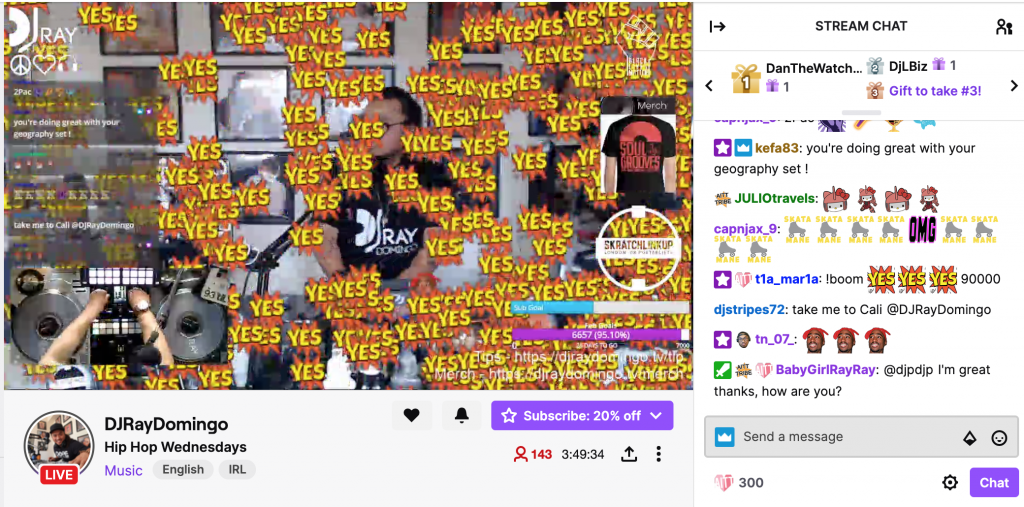
So, hopefully I’ve covered a decent amount of info for you and demystified a lot of what intimidates newcomers!
Its likely that I’ve missed some things from this round-up – what I would say is, don’t be afraid to ask questions! People are super friendly on Twitch, and usually streamers and other viewers are happy to explain things. Volatile even takes the time every Thursday to stop his stream and explain exactly how it all works. As I learn more, I may write another post explaining the things I pick up along the way!
While you are getting your Twitch channel ready, or bouncing from stream to stream as a viewer, go pick up the best music at the Heavy Hits pool, and go follow my twitch here!

New Year’s Resolutions!
Its that time of the year! Where we look back at the year just gone, make plans for the new year ahead – and where we commit to resolutions, to improve ourselves and our lives one way or another. Its a great opportunity to try to start good habits or end bad ones, so here’s some suggestions for resolutions that DJs may find useful, or might spark ideas for other resolutions that suit you better!
Explore Music
You could make a commitment to listen to more new music – and that doesn’t mean it has to be music that came out recently. You could go through classic Essential Mixes, a treasure trove of brilliant music by some of the best DJs around. You could pick a top albums list from say Pitchfork or Rolling Stone or Source, and listen to each album, day by day, then move on to a different list at the end. You could use the Spotify algorithms to your advantage, as I explain in this article (along with a bunch of other strategies, such as checking out radio playlists).
One of the greatest things about being a music lover is that every day is the best day in music – there are new tunes coming out every day, PLUS you still have the entire history of music to explore! Trust me, if you search, you will find bangers!

Practice Yo Cuts!
2020 has been a year where being nice on the cut has been a HUGE advantage, because of the emergence of video livestreaming as one of the major ways for DJs to connect with their audiences. Obviously, not everyone is going to be able to reach 3style champion levels of technical expertise, but being tight is a benefit to any DJ. And with the fact that eyes are very much on your while on-screen, it adds a valuable visual element to your sets if you are able to cut, scratch and juggle a bit, and can help you differentiate your mixes from other DJs’.
There are loads of great free scratch tutorials on Youtube, and loads of paid-for services from badass scratch DJs like DJ Angelo. Even just 10 minutes a day scratch practice will make a big difference if you stick to it consistently.
Develop Your Online Image
Like it or not, your image matters. And these days, your image is largely represented online, much of that through your social media channels. From conversations I’ve had with industry people, the first place any booker looks when checking out a DJ is their Instagram. Facebook and Twitter are worth maintaining if you have them, and having your own website doesn’t hurt either. But if you want to maximise the chances of making a good impression, think about how your Instagram looks, think about the image you want to present to the world.
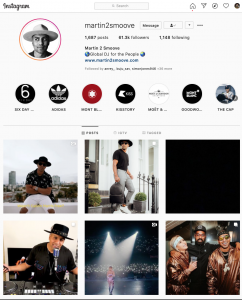
There is no “correct” way to do this. But there are ways that are more or less effective, depending on what you want to achieve. Posting consistently (both in terms of timing and in terms of what content you share), engaging with fans who comment, commenting on the posts of others to become part of a wider community – all these things can help. You’d be surprised at how little research some bookers do – they want to go look at a page and check someone is legit, and so if they have to wade through several dozen unrelated posts to get to anything that shows you at work, they might conclude that you are not a serious DJ. That doesn’t mean you have to do things a specific way – my Instagram has plenty of pizza photos and duck videos – but do so in full knowledge of the impression you want to create, the relationship you want to generate with followers.
Look at the social media of DJs you admire and want to emulate – see what lessons you can learn from what they post and how they post it.
Develop Your Studio Skills
One of the realities of the modern DJ game is that it is a HUGE advantage to be putting out your own tracks – be that originals, remixes, edits, mashups, whatever! A huge aspect of getting booked is name recognition – you will struggle to make your name known in Sydney if you live in New York from your DJing alone, but have a remix of yours become popular and suddenly DJs all over the world will know your name, and DJs around the world are often the people throwing parties and shaping the musical tastes of those around them.
Another benefit of this is that you can make exclusive edits for yourself, meaning your sets can be more unique, and the better you get at making music, the more you will understand the musical dynamics of building a good DJ set. The two skills are not necessary for each other, but they sure do help the other along!
Go check out DJ AndOne’s amazing Youtube channel, where we walks through how he makes his amazing edits and remixes!
Learn Music Theory
Serial badman DJ Freefall suggests learning more about the technical side of music, and even if you aren’t making music this isn’t a bad idea – understanding the language of music just gives you a far more rounded understanding of what works and why, so that you can take even greater control of your audience when DJing.
Tidy Up Your Library
It is the eternal struggle of the digital DJ – thousands of tracks, and trying to organise them in a way that makes sense, which allows easy access to what you need, stops you falling into repetitive ruts, and most importantly keeps you inspired and creative.
We had an in-depth conversation with DJ Freefall about this very subject here – I’ve commenced this mission, and it has helped me rediscover all sorts of things I’d forgotten about, and make musical connections I never would have before. And it is the new year’s resolution that keeps on giving – when you have as much music as I do, this job is never complete!
Clean Up Your Library!
One thing I have realised in the age of livestreaming is that a lot of the music I play in clubs is FILTHY. Tracks I never batted an eyelid about playing to 18+ crowds take on a whole new dimension when you are playing online, to crowds that include people’s kids! I have done a fair few corporate performances, via their social media channels, or private Zoom parties to company staff. And it is a horrible feeling to realise that you only have the dirty versions of tracks you want to play. Its an even more horrible feeling to play a track you didn’t realise was dirty and suddenly you are swearing to the CEO’s cute little daughter on Zoom!

The easiest way for a lot of these is to head to the Heavy Hits Pool and pick up the clean versions of as many of these tracks as you can – these are all carefully and accurately labeled. If you can’t find clean versions, then making them isn’t too hard – the simplest way is to open the tracks in a program like Ableton Live, highlight a swear word, and reverse that section of the track. If you just do the word (rather than a whole sentence or phrase) then the brief section of backwards audio sounds fine. Once you’ve done it a few times, you’ll find the knack for doing it well!
Make Notes When You DJ
Maybe not “notes” exactly, but @tecksound2 on Twitter made a great suggestion – comment, tag and star tracks for later on, so you don’t forget about an amazing track, or a great sample you found, or a cool lyric to do a wordplay with! I have a version of this I have done for a while – when I’m playing a gig, if I do a particularly great mix, I take a quick screenshot, and then I can refer back to it at a later date. I’ve used these ideas as the basis of quite a few mashups and edits, and its handy for when making a mix and wanting some quick ideas of blends that worked really well for me in a live setting.
Turn Your Practice Sessions Into Social Media Content
DJ Sam Flanagan made a great suggestion, which I may actually copy – film scratch practice every day, and then edit this into a weekly highlights package. He’s also planning to to make 1 scratch routine per day that will feed into his practice, and theming them weekly (eg, Beastie Boys one week, De La Soul the next) – another great idea!
This ticks so many boxes for DJs who scratch – you get to practice your skills, you deep dive a different artist each week (meaning you’ll probably discover new tunes, or old ones you forgot about!), it creates relevant content for social media, and then when gigs come along, you have a whole treasure chest of routines to pepper your sets with!
Most of all, have fun!
If you’re doing it right, you DJ because its fun to you – its so important to keep that flame alive! New year’s resolutions are very useful, but never let them get in the way of your love of music, the joy of entertaining people, the thrill of trying something out that you’re not sure of, and it just works. I’ll likely try to take on a few of the above resolutions, and hopefully most of them will stick – if not, no worries!
2020 has been an incredibly tough year for the DJ community, and it will probably be a little while before 2021 approaches whatever “normal” looks like these days. But we’ve made it through this far, and if we’re smart we can get back to the clubs as better DJs, and make sure we are ready to capitalise on the parties that will be coming! A lot of DJs won’t be ready – make sure you are! Stay on top of the latest releases, keep your skills honed, let people know you are still doing the damn thing!
From everyone here at Heavy Hits, we wish you a happy New Year, and hope that only good things come your way in the year ahead!
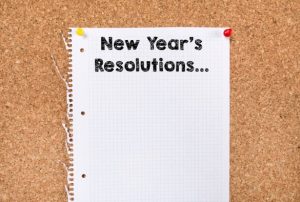
Serato DJ or RekordBox DJ – Which is best in 2020?
For today’s post, we have a special guest column, generously shared with us by DJ Tech Reviews – be sure to bookmark that site for more of this sort of content! But without further ado… Serato DJ or RekordBox DJ – which is best in 2020?
Ah, the age-old question – Serato DJ or RekordBox DJ – Which Should I Use? Let’s face it, one of the toughest parts of succeeding as a DJ is deciding which platform to use.
When you are trying to deliver an epic performance, you need software that helps out with things like collecting and organizing your sounds. Tools like Serato DJ and Rekordbox DJ are ideal for that exact purpose.
The only problem? There are plenty of reviews out there from pros ranting about the benefits of one platform or the other. However, it’s tough to find comparisons that help you choose one tool over another.
That’s why I’m here to help.
I’ve explored all the ins and outs of both the Rekordbox and Serato platforms to bring you this head-to-head guide.
Let’s dive into Serato DJ or Rekordbox DJ – Which Should I Use?
An Intro to Serato DJ or RekordBox DJ
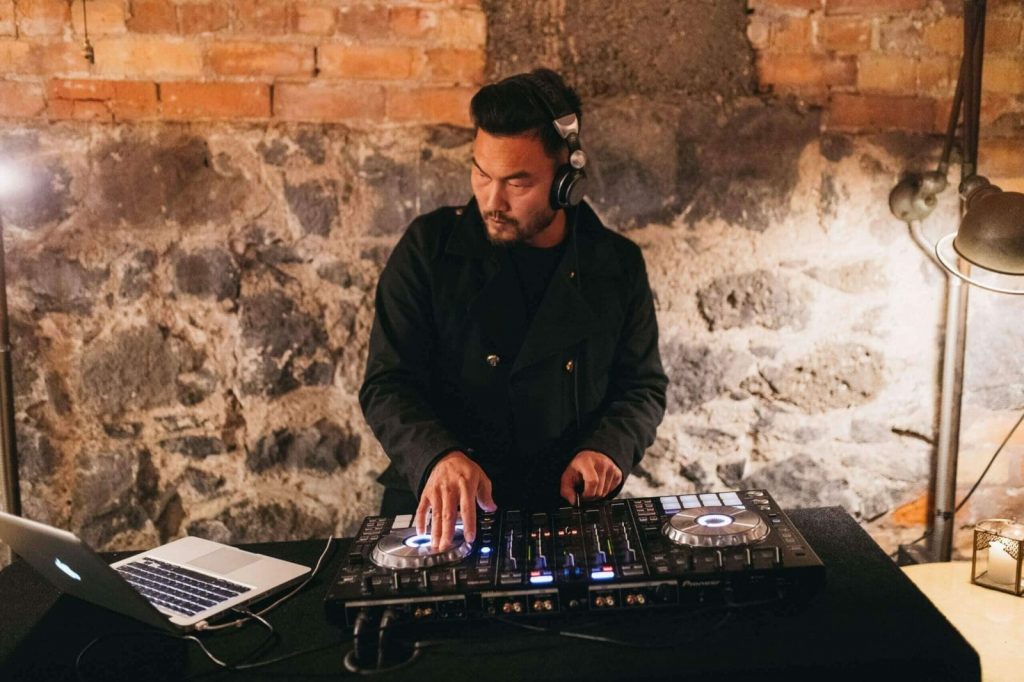
Both Serato and RekordBox DJ are considered reliable and practical options for the modern DJ. They’re teetering on the cutting edge of the industry, delivering high-quality tech for many respected artists.
Serato first launched in the mid-2000s, and it’s evolved with the DJ landscape since, offering access to everything from turntables, to DJ controllers and media players.
Rekordbox is the software from Pioneer DJ, originally designed to help DJs organize and export tracks to USB drives. RekordBox DJ also comes with a performance mode that allows you to spin via your laptop and a DJ controller. It’s pretty similar in functionality and style to Serato.
At first glance, you’d probably struggle to tell the difference between the two.
Both Serato and RekordBox allow you to organize your music collection, save cue points, tweak FX elements, and display tracks with visual waveforms. Both options are stable (though one is better than the other here), and they both get regular updates from developers.
So, what really sets these tools apart?
Serato DJ or RekordBox DJ: Features
Let’s take a look at the features available from these two platforms.
Serato’s built-in feature set is pretty awesome on its own. However, there’s also a bunch of expansion packs available too. For instance, you can access Serato Video to access an in-built video editor, adding synced sets to your system in minutes.
Check out this video walkthrough to get you started:
Serato Flip means that you can remix your tracks quickly and easily for playback, while Serato DVS allows you to connect CDJs and turntables with timecode discs and vinyl. You can also try Serato FX for FX customization, Serato Pitch and Time for shifting pitches, and more.
If you want to learn more about Serato DVS then check out this video:
The experience of working with RekordBox is very similar to using Serato. However, RekordBox is compatible with fewer controllers, you can only like 22 controllers, 12 mixers, and 10 CDJs.
Check out this video walkthrough to get you started:
Within the RekordBox software, you’ll find a sampler, FX tools, edit and remixing tools, and more, all comparable to Serato Flip. You also get a version of Pitch and Time, which helps with transitioning between tracks.
Rekordbox also offers many expansion packs similar to Serato, such as RekordBox DVS, with timecode control for scratches and timecode vinyl setup. There’s also RekordBox Video, for visual effects, and RMX effects. RekordBox arguably gives you more for your money out of the box, but Serato DJ is a little more expandable. In my opinion, Serato DJ is excellent if you’re looking to mix exclusively on laptops and controllers. However, if you’re looking for a more old-school style with Pioneer CDJs, then RekordBox is going to be your go-to choice. It’s excellent as prep software for CDJ playlists.
Serato DJ or RekordBox DJ: Hardware
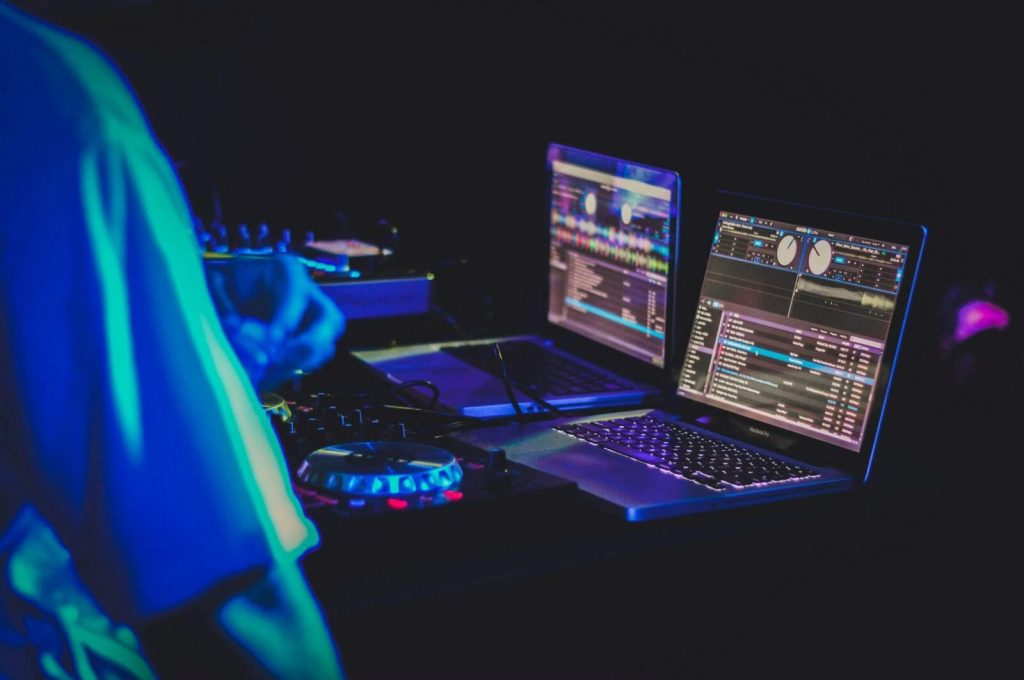
Serato is probably one of the broadest DJ software solutions on the market today. Pretty much any controller that isn’t manufactured by Native Instruments or Pioneer uses Serato. This means you’ve got a lot of choices. Serato integrates with 53 controllers, 16 mixers, and four different interfaces. There’s also integration available with up to 14 accessories, such as FX controllers.
The difference between Serato and RekordBox is a bit like the difference between an Apple or PC. One keeps you firmly within its own ecosystem, whereas the other is more flexible.
RekordBox is pretty much your only option if you’re going to be mixing on Pioneer CDJs. RekordBox is an extension of Pioneer’s free music prep software, offering laptop-based control. Since Pioneers are titans of hardware in the DJ industry, RekordBox is going to appeal to a lot of pros.
RekordBox has the dominance here for CDJ mixing, but its flexibility is pretty limited.
Serato DJ or RekordBox DJ: User Interface
Serato DJ’s interface is very similar in style to RekordBox DJ. Compared to options like Traktor, the interface is a lot darker and more serious in style.
Serato’s interface is packed full of information, with in-line vertical waveform displays and plenty of features to explore. It does take a while to find your way around the software, but you’ll figure it out eventually. I’d recommend giving yourself at least a few hours to experiment.
One of the best features of Serato is the browser. The Smart Crates system allows you to find the tracks you’ve improvised for your set instantly.
Alternatively, RekordBox also looks ultra-professional, with a very sleek and minimalist appearance. The side-by-side track view is a nice extra touch.
A great thing about the RekordBox interface is that you can still use it when you’re not connected to a deck or controller. This means that you can try different combos of tunes at any time, even if you’re just hanging out on the catch.
Although both interfaces are pretty impressive from an objective standpoint, RekordBox is just a lot nicer in my opinion it is just a lot cleaner, and you can use it without a controller.
Serato DJ or RekordBox DJ: Stability
Stability is always going to be crucial for DJs. You don’t have to worry about things like gigs stopping in their tracks or destroyed libraries in your software when you have stability. Years of patching and tweaking have made most modern software pretty stable.
Serato is very stable, and it works well on a range of older machines. For instance, you can even use it with a MacBook Pro 2011. If you haven’t upgraded your laptop in a while (like me), then you should do fine with Serato.
On the other hand, RekordBox is built on the Pioneer framework, which hasn’t always been known for its stability. This system wasn’t designed for live use, and it showed. However, the interface is a lot better today with much more reliability.
In my opinion, the Serato DJ is just a touch more reliable overall.
Serato DJ or RekordBox DJ: Pricing
We all have budgets, right?
Serato DJ full license comes free if you buy an expensive controller. However, you can buy Serato Intro and upgrade to Serato DJ at $129. Expansion packs cost anywhere from $29 to $99.
If you want the DJ Essentials Club Kit package, you can buy that for $169, and the Serato DJ software will come with it.
RekordBox is free to use itself. This is the prep software for loading your tunes onto a USB drive without a laptop. RekordBox DJ, on the other hand, costs $139. Expansion packs can range from $10 for additional FX to up to $159 for video.
The Pioneer brand bundle RekordBox DJ in for free with every Pioneer controller, however, even the cheapest ones on the market.
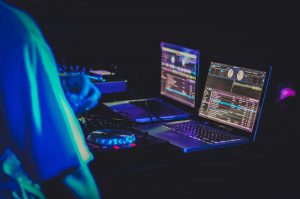
The Many Ways To Be A DJ – Residents
The first instalment of this series is going to look at one of the most common types of DJ, the local resident. Its not as glamorous as some parts of the DJ world, but it can actually be a very useful corner to establish yourself in!
It offers more job security than the average, less time spent schlepping from A to B for gigs, a chance to develop a relationship with a regular audience and go on to running your own nights, and much more besides. And in terms of developing your skills as a DJ, few things can beat regular gigs – a huge amount of famous DJs started out with regular low-key residencies, where they honed their craft before breaking out into stardom!
I have a lot of experience of this sort of DJing, having started my career nearly 20 years ago with a couple of £40 a night residencies at a bar where I had been a glass collector. Over the years I’ve been to the highs of a Red Bull 3style Final and playing clubs all over the world, from Bali to Nairobi to Berlin, but in truth, it was my local residencies that continued paying the bills month to month for most of my career.
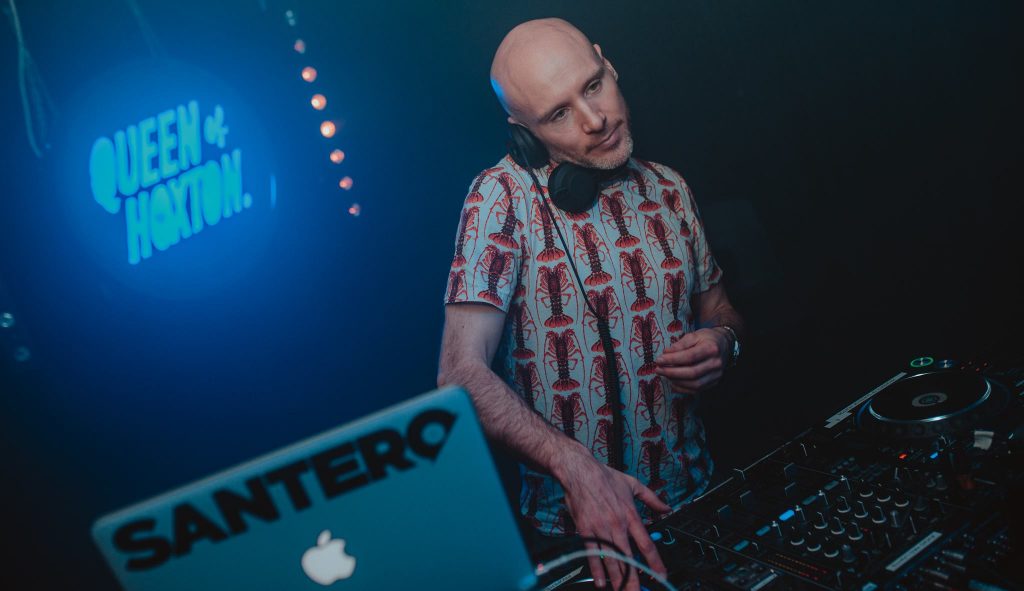
Getting Started
So how do you even get yourself booked in the first place? There’s no single correct answer, but a good starting point is to attend the venues and parties that you want to DJ at. Get to know the staff, get to know the crowd, and what they want. When you know who books the DJs, thats when you can maybe pass them a mix and ask about the possibility of a set. And of course, as happened with me, if you work at a venue in some capacity, you’e able to put yourself into contention for sets that might come up.
A few things to consider – don’t be nasty about the current residents. For a start, there’s a good chance you will end up working alongside them, either together on nights or sharing sets through the week. They are also most likely friends with the people who you are trying to impress, so coming in there and saying “This DJ sucks, looks stupid, and smells bad – you should book me!” is not going to go over very well in most cases…
Don’t take it to heart if they don’t ring you back within 24 hours of you sending them a mix, begging to put you in the primetime Saturday slot. I DJ occasionally at a very exclusive venue in central London, and when I was having a meeting with the booker to work out if he wanted me there, he mentioned how he received about 5-6 mixes on email per day.
Think about that for a second – there is no way on earth he is going to listen to all of those, and those he listens to, it is very unlikely that he will listen in full. Not every booker will be bombarded quite like that, but you get the point. And this tale goes back to a point mentioned above – I only got to meet the booker because I had a relationship with a manager at the venue, who recommended me from previous work we had done together. Does the value of creating relationships with front-of-house staff at venues start to make a bit more sense now?
Once You Have A Set
Heavy Hits’ own Isaac Jordan is a very experienced resident, at venues all over the USA and the world, including in Philadephia, New York, Atlantic City, San Francisco, Barcelona, Qatar and the Philippines. This shows what local residencies can lead to – he started in his home town and built up a rep, then moved to other cities in the States, and ended up travelling the world for residencies in multiple countries, staying at each place for several months or years at a time!
He has some simple advice –
“Understand the vision of the venue, be friendly with the staff, connect with local DJs and include them at your events if possible. Learn about songs that are big locally”
This chimes with what we spoke about above. If you turn up and just play what you want to play, with no consideration of what the venue and the management (and the patrons!) want, well… maybe you’ll get lucky and you’ll be so amazing that it doesn’t matter. But it is more likely that you will miss the mark. Before the pandemic the DJ scene was incredibly competitive. It is likely to be even more so now, with many venues closing or reducing the number of DJs they have on, and DJs are even undercutting each other to get the gigs that remain.
Having proper conversations with management about what they want from you is a key factor in securing a residency long term. Some place will want to really rock it, others will want you to just keep it bubbling without it ever getting too rowdy. A common thing in bars is “rotating the dancefloor” in order to take more money at the bar – what that means is to change the music up every so often so that people decide to leave the floor and go get a drink. Its a strange thing for a DJ to get their head round, but if you can master it, you will be much more valuable to clients. The trick is not to clear then fill then clear the dancefloor over and over, but rather to have it changing through the night, so different groups go back and forth at different times.
As we discussed above, being friendly with the staff before you join can help you get a gig in the first place. When you are in there, its possibly even more important. While DJing you have your window on the party, but its hard to get a sense of how the whole venue is enjoying the night. You can pop out for a quick walk around the venue occasionally to get a sense of how things are, but this is tricky to do at peak times. Bar staff, security and management, however, will be speaking to customers throughout the night – getting feedback from them at the end of a night is always a good idea. It might knock your ego a bit – I’ve had times where I thought I’ve smashed it, then somebody mentions criticism that a customer made, or even they make their own.
The key is to take this on board, not get annoyed at the person delivering the criticism. Every DJ makes mistakes, every DJ has parties where it just doesn’t click. Learning about your weaknesses will prepare you better to tackle them when they come along during your career.
We’ll speak to Isaac more for a later article, about global residencies!
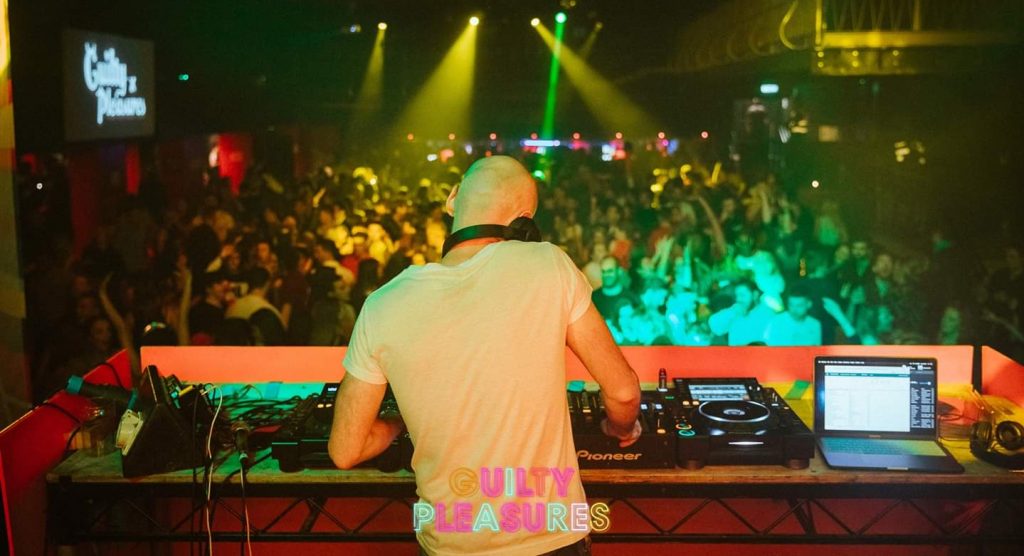
What Do Bookers Want?
I spoke to a couple of successful London bookers I work with to get their side of the story.
Oliver Lewis is Head of Promotions at the Blues Kitchen venues, Metropolis, and The Old Queen’s Head.
Resident DJs are the lifeblood of any venue. I believe that being a resident can really refine the skills of a DJ and once established help showcase their style to more people; but as a booker, club promoter & festival organiser it goes beyond this. A great resident can really help establish the tone and vibe of a night or event, and over time a venue.
When choosing a resident, I am very selective, especially when bringing someone in for a regular weekly show. Other than musical taste and a base level of ability, which always comes first, the number one consideration for me is if they care.
Are they reliable? Do they turn up on time, with the right equipment, having prepared for the set? Will they mix up the set each show, rather than just playing the same tunes week in week out? Have the looked into who they are playing with and engaged with them?
There is nothing worse than a DJ turning up 2 mins before their set who hasn’t got their headphones and doesn’t know how to set up their own equipment. Worst of all is the DJ who just has a big generic playlist that he or she is going to randomly select from. Instead, you want someone who will think through what will work for the night, the headliner, the time of their set and who has planned their track list around this. Again, it just comes down to whether they care or not.
So you can see there that it pays to be invested in the sets you are taking, and really showing care and attention to each one (and not getting complacent once you have a residency or two!)
Fabio Limao books for the Barrio venues in London…
I have booked the DJs for several different venues over the last 15 years. Technically speaking, of course it takes a vast musical repertoire, capacity to take musical briefs, and professional mixing skills.
But, success for a regular DJ depends a lot on social skills too. During the time spent at the venue, the DJ is part of the team, and needs to act like that, liaising with all members of security, management and staff to help managing the environment according to what’s expected.
Also on the social skills box, dealing with costumers is also a must. It doesn’t mean doing playing everything they ask – that bit depends on what is agreed between the venue and the DJ – but definitely, one must makes friends with the punters, rather than create a hostile relationship. Even when the clients are unhappy and sometimes annoying. And drunk…
They need to be dealt with nicely, regardless their attitude. That takes more experience than actually playing music sometimes!
Fabio makes a great point here. When you are the resident at a venue, you are a representative of the venue. At parties, you will often get hassled by annoying, drunk patrons. You will get endless requests. Now, you could swear them and tell them to get lost, but do you think that the kind of person who provokes you to do that is going to go “Oh, OK then, I will quietly leave, and that is the end of this”?
Or do you think they will kick up a massive stink, demand to speak to the manager (wasting their time right when they are at their busiest), maybe leave a negative review or two online when they get home, bad mouth you and the venue on social media, etc etc?
So, developing a thick skin is a must. Learning how to phrase things firmly but diplomatically will really help you. Having fun with terrible requests, rather than getting upset or angry, is basically a superpower for a resident DJ.
And another point Fabio makes is crucial – requests are fine, and you WILL get a lot. But if the venue booked you specifically to play house, and someone is demanding hip-hop, the venue wins. They are the ones paying you after all! This is where getting creative can help you – maybe you have some house remixes of big hip-hop tracks, maybe you scratch an acapella and create a live mashup over an instrumental house tune. Finding ways to keep a diverse crowd happy is the key to being a successful resident.
Logistics
One thing that is a reality for the average resident DJ – you ain’t getting the sort of riders that big star DJs get, either technical or hospitality. Adjust your mindset to that, and work within those parameters.
One thing I always hammer home to DJs I’m mentoring – BE PREPARED. Have a read of this article from a few weeks ago, and be prepared for as many eventualities as possible, because the quickest way to lose the confidence of a residency is to not cope with one of the problems that will inevitably come along.
Familiarise yourself with the equipment they have. Go along with the staff member when they’re switching over from the house system to you – find out how it works. You’d be surprised how often you find yourself at a venue, and the one person who knows how the amps/speaker system works is on their day off, and nobody knows how to get the music from the DJ on the system! If you know how to do this, that will save a lot of hassle if that happens – nobody will give you much credit for it, but it’ll save a lot of stress
In the booth, who knows what may await you – sometimes, its worth bringing your own mixer if that is possible, or even an all-in-one controller depending on the circumstances.
The sad truth at a lot of residencies is that venue staff have no idea how to look after equipment, they often don’t have dust covers, people don’t clean the decks, and other DJs get messed up and spill half their tequila shots over the electrics (obviously, you’re so professional that you would never do that, right…). And rarely will they think it is worth upgrading to the latest equipment if whatever they have on-site turns on OK!
Be clear with the venue as to what you get in terms of drinks & food – some places will give you a tab of a fixed sum, and you then pay any excess amount, some places might give you a certain amount of drinks tokens, and so on. But clear this up! I played at a very fancy hotel bar, and the head waitress kept asking if I wanted another drink, and bringing me amazing cocktails, which I had assumed were on the house as she offered them to me a certain kind of way. Roll on to the end of my set, and suddenly I’m presented with a bill that was roughly 50% of my fee! A mistake I won’t repeat again!
Money
Be clear about payment as well – do they need an invoice, is it cash on the night or bank transfer, how long will a bank transfer take, etc etc. DO NOT allow a venue to stack up thousands on unpaid invoices. I have seen places do this to DJs, then go bankrupt to clear their debts, before being up and running before you know it. It is STRESSFUL to have months of unpaid work you are chasing – so try to establish boundaries and parameters early on to avoid this problem. Most places are fine, and these days its generally invoice/bank transfer. I have a note on my invoices – if they go past 30 days unpaid, I can add £40 + interest at the Bank Of England base rate + 8%. Dangling the reluctant threat of this almost always gets invoices paid very fast!
In my experience payment generally takes 7-14 days from most venues.
Don’t be shy about asking for a pay rise if you have helped the venue get busier and increased the bar take. Be realistic, be polite, but if you’re helping them make more money, maybe you deserve a taste. They would certainly not be shy about getting rid of you or reducing your fee if those numbers went the other way! Sometimes, I have had deals with venues where I get a fixed amount as a basic fee, and then a percentage of the bar take over a certain threshold.
Be A Team Player
If you are going to be somewhere weekly, you want to be part of the gang. Help with promoting the venue on social media. Get your friends to come down, and go down there on your nights off if you can, all chip in with positive reviews on Google & Facebook. Clean up your DJ booth after yourself (bar staff are always very grateful to me when I do this, which suggests it is quite rare!), keep an eye out for troublemakers for the security team (the DJ always has a great vantage point for this).
I have made many lifelong friends from my residencies over the years. And you never know where people will go on their careers – I’ve seen glass collectors I was friends with at one residency go on to be managers at clubs I am desperate to DJ at. Make the most of your time in your residencies, and it could be the start of many great things in your life and career!
I’ll be back in a few weeks looking at another corner of the DJ world, until then check me out over at Instagram, and head over to the Heavy Hits Pool for the best music!

Arranging Your Crates, with DJ Freefall
A lot of people tend to have this idea that DJs are super cool rock-stars, and maybe a few are. But one of the unglamorous realities of DJing has always been its proximity to being a librarian – back in the day, it was shelves of thousands of records that you had to arrange so that you could find what you needed, and now its endless MP3s and WAV files on your laptop.
I’m like many DJs, in that I have way more songs on my computer than I will ever play, and as a result, staying on top of the naming, tagging and filing of these files is extremely important.
I have never been terrible at this, but I’m nowhere near being an expert. Which is where the don DJ Freefall comes in! We sat down on Zoom for a chat about how he manages his digital music library, and it was an eye-opener!
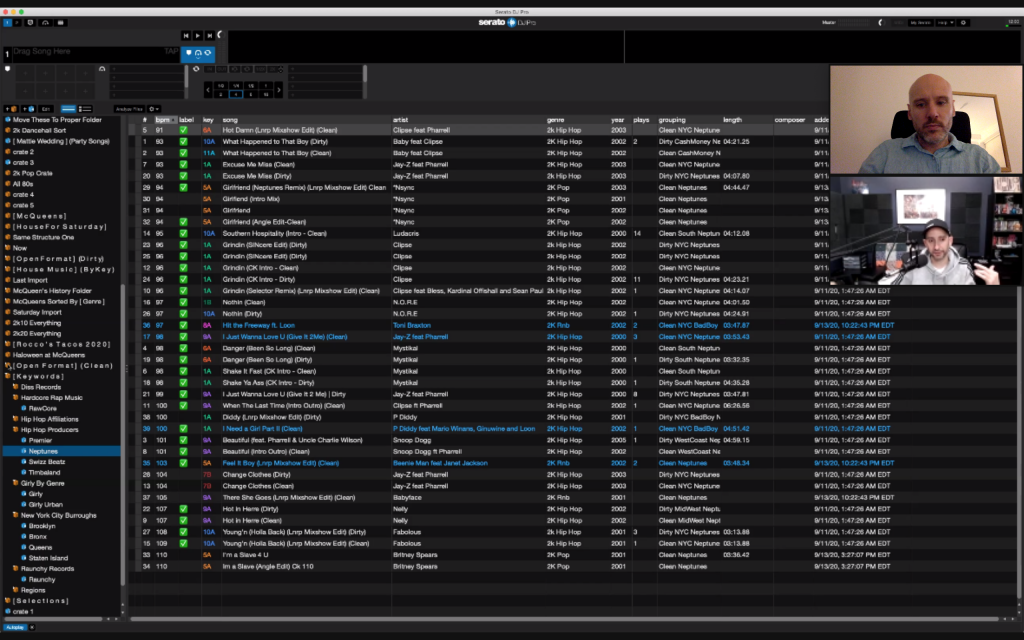
The key to his system is Smart Playlists. We both use Serato, and so much of this conversation will relate to that. Obviously, Smart Playlists exist in iTunes/Music, and many other software programs, so the concept will map across platforms. Freefall actually uses Serato as his primary music management tool – I use Apple Music (formerly iTunes) as my primary, with those playlists sync’d over to Serato, and some crates in Serato.
The basic concept of a smart playlist is that you create a set of rules, and then any track that fits those rules is automatically sorted into that playlist. What this means in practice is a fair chunk of work up front to tag your existing library correctly, then a little extra work every time you import new music to your library and to create the smart playlist rules, but the pay-off is an incredibly well organised music collection, playlists constantly updated with suitable tracks, and amended as you change tags on your music.
Here’s a simple example. I created a smart playlist in Serato, and created the rules “year after 1989”, “year before 2000” and “genre contains hip-hop”. All tracks which fit within those parameters are automatically filtered into this playlist. If you want to amend, delete or add rules, simply select the playlist and then click on the “edit” button to the right of the blue smart playlist icon to the middle left of the screen. You can have just one rule (for instance, have all your clean/radio friendly tracks sent here), or absolutely loads of rules stacked on top of each other to really finesse down to specifics.
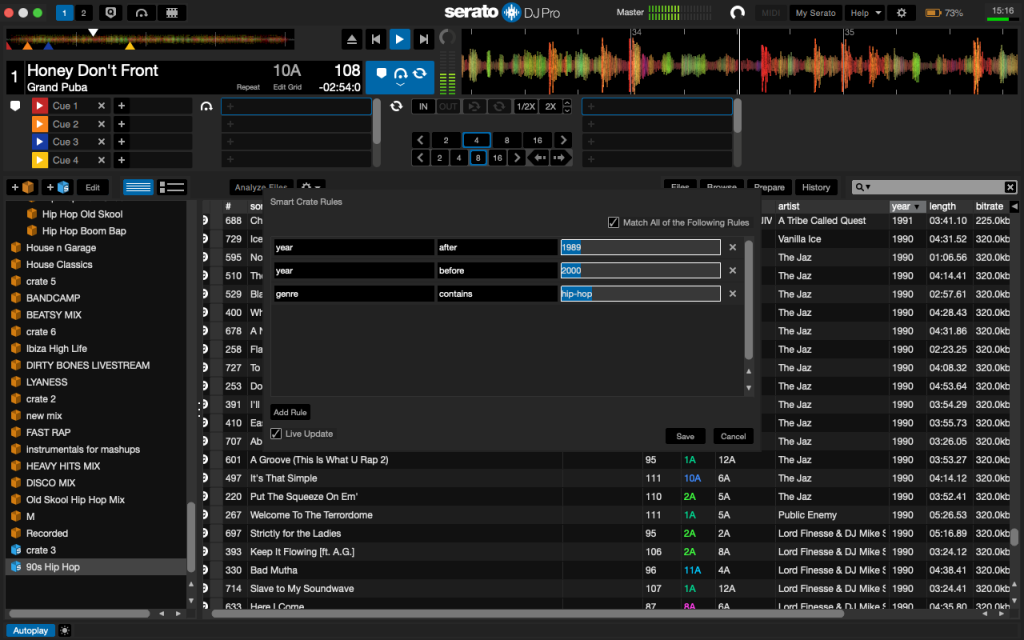
So far, so good. But I have 20,000 tracks or thereabouts. They are tagged in all sorts of different ways, so how do I get to a point where I can apply a handful of rules and trust my collection to be sorted right? Fortunately I have always been pretty good at keeping my genre and year tags pretty accurate, and Heavy Hits tracks are scrupulously detailed in this regard! What Freefall introduced me to allows me to take this to the next level, and is very clever indeed.
He uses a great piece of software called Meta for batch tagging – meaning you can tag huge numbers of tracks at once. Its either a one off payment (£20), or you can get it as part of an app subscription service called Set-App, which is $10 a month (slight discount if you commit to a year). With this you can tag loads of tracks at once, and it has some really useful functions for tidying up your library.
BE CAREFUL THOUGH – I rushed headlong into this, and accidentally caused an issue with Music not seeing several thousand files, even though they were still in the same place, as I had accidentally changed the artist field! So start off with small batches of maybe a dozen songs at first while you get familiar with how it works! Better safe than sorry!
Freefall’s killer trick is to insert personalised tags into the “grouping” field – you can put what you want in there, but basically the idea is to have simple descriptive tags which tell you info about the track, then you use these to create rules for your smart playlists. So you could take different selections of tracks, give each one a different tag in grouping, and end up with one of them having all of “90s” “banger” “girly” “singalong” “handsintheair” “classic” “cheese” listed in that field. Important thing to remember when creating tags – add a space before writing out your tag, so that it doesn’t just come out as one long word.
IMPORTANT NOTE!!! – Apple Music is setup in a way that mean that the grouping field from Meta shows up in a field they call “Work” (it shows up correctly under grouping in Serato. To Meta’s credit, when I emailed them asking why nothing was in the “grouping” field, they replied in under 24 hours with a comprehensive answer, which is always reassuring when using an unfamiliar piece of software!
Below I show basically how the process works – I dragged a bunch of bangers in to the app from iTunes. Selected all, then right clicked with the cursor over the grouping field, which means the menu that emerges gives the options you see here. Entered a space and then “banger”, then hit enter – hey presto, the word banger is inserted after whatever else was already in the “grouping” field. I can then set up a smart playlist using that in a rule, alongside whatever else (genre = pop, year 2000-2010, bpm 120-140 or whatever), and have a nicely specific playlist create itself.
Again here, BE CAREFUL – if you delete the light blue rectangle in that field that says “grouping” then enter, you will delete any grouping data that was in this field! Likewise in the title, album, artist field, the same principle applies – delete the light blue box and you will delete ALL the titles or whatever field it is you are editing, and you don’t want to do that I expect! The idea here is that you add tags to what is already there, not replace it (unless that is specifically what you are trying to do for whatever reason!).
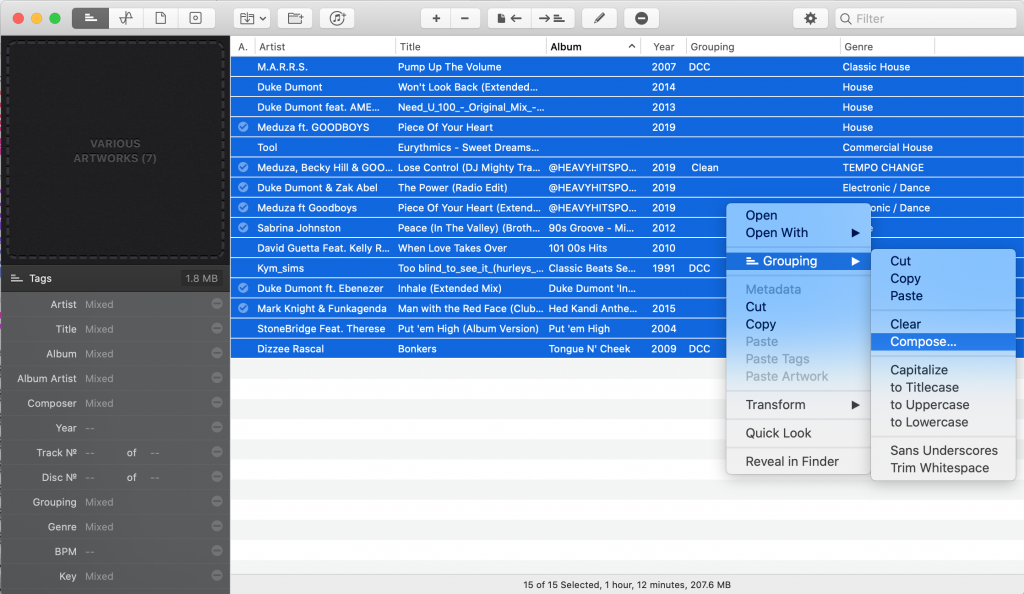
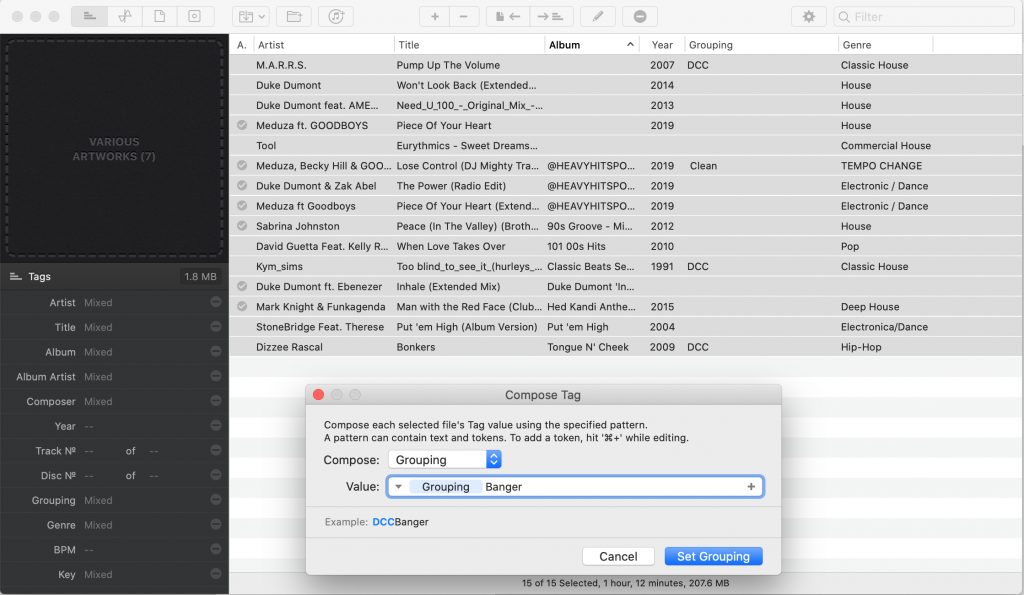

One of the tracks in there gives me a good opportunity to show off a cool feature in Meta. The Kym Sims track contains a load of underscores and an annoying lack of capitalisation. My library is full of tracks like this.
If you select the track, right click, and head to Transform, you can click “sans underscores” which automatically deletes all the underscores in a file title and artist. And then I used “to Titlecase” to get the capitalisation how I like it.
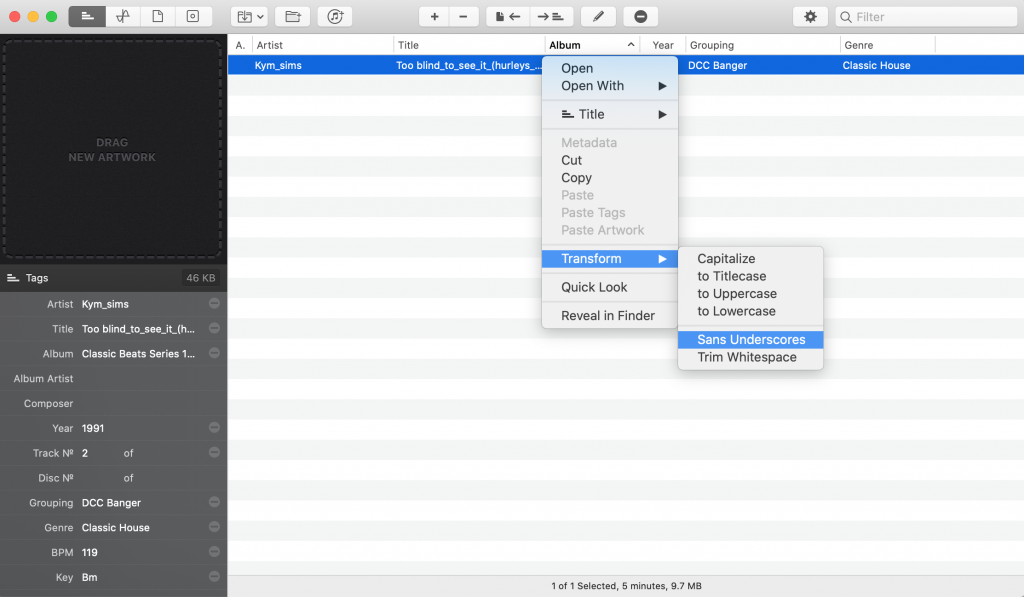
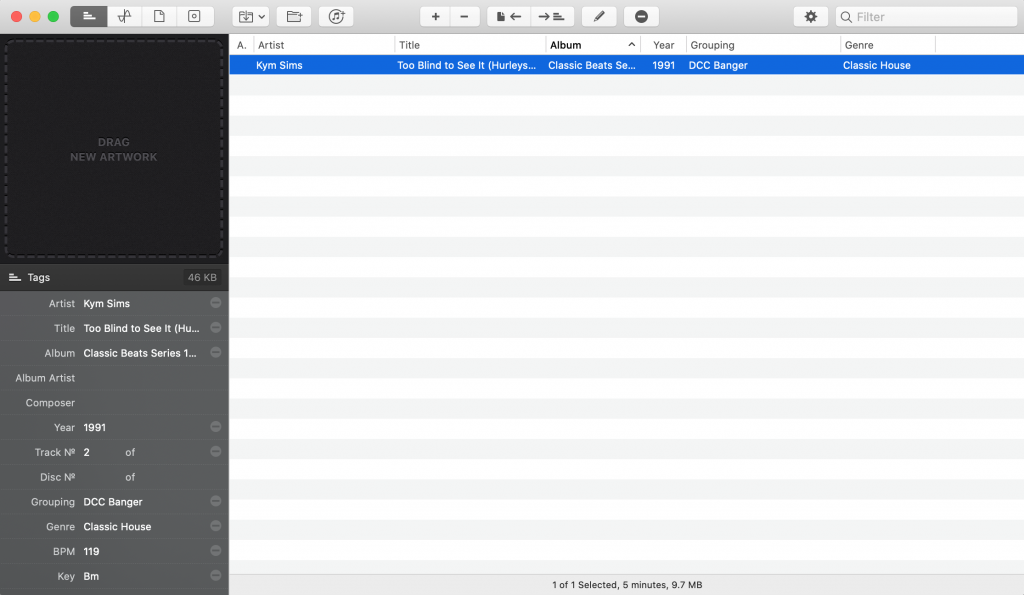
As you can see, its a really handy tool for managing a large music library.
Obviously, as mentioned earlier on, even with this batch tagging tool, its a pretty time-consuming job to do this with a large collection. But the payoff is pretty spectacular once you get to work on your smart playlists – as you can see on the screencap of Freefall’s Serato at the top of the page!
Some other useful things to mention… If you look back at the image of Freefall’s Serato at the top, you can see that some of his tracks have the ✅ symbol in the “label” field. This means that at a glance he can see tracks that would slot into an open-format set. I am 100% stealing this idea for my own library!
I’ve also run my collection through BeaTunes – this has been very handy for finding artist names on files that had that info missing for whatever reason, and tidying up a bunch of info inside the files. This syncs easily with Apple Music, and can be left to process loads of stuff. Its not perfect – I’ve found it struggles with quite underground dance music, and obviously edits and mashups tend to throw it! But it sorted loads of stuff out fast.
You can also set it to analyze a bunch of very odd and subjective factors – I’m fascinated to see how this works out in practice. It calculates mood, danceability, assigns colours to tracks and more! Very weird, but interesting… Not sure why Legs gets a big fat zero for danceability!
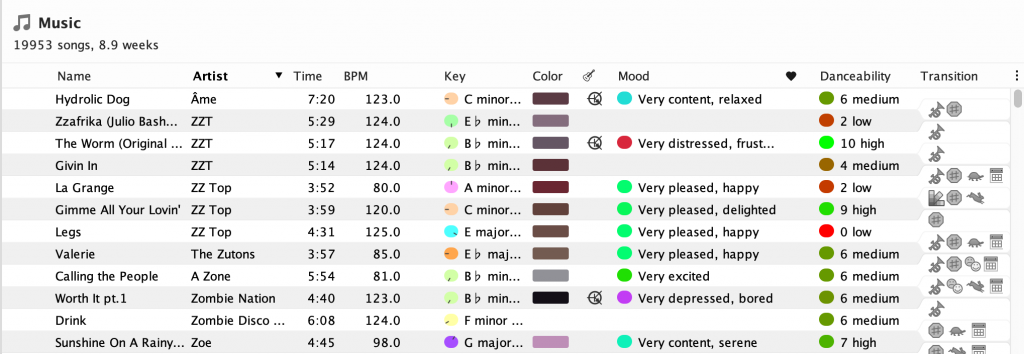
So as you can see, this is the kind of thing where you can go quite deep. But I am very impressed with Freefall’s approach with smart playlists, which strikes me as an extremely smart way to set your library up.
As you can see in the image at the top, you can set things up by city (and even borough in the case of NYC!), by producer (every Primo or Neptunes song conveniently together!), affiliation (have every Wu-Tang affiliate filter down into a single folder!), and so on and so on… the only limit really is your imagination and your patience setting it up. You can have “big reaction/hands in the air” tracks, singalong anthems, energy-diffusers, end of night tracks, songs used in adverts, whatever!
I can’t wait to get my library where I want it to be in this enforced time away from the club, and I hope that this post inspires some of you to do the same! Big up DJ Freefall for so patiently explaining all this stuff to me, go give him a follow!
And the meantime, follow me over at Instagram, and check out the latest heat on the Heavy Hits pool!
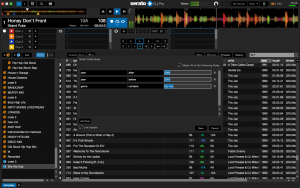
The Many Ways To Be A DJ
On my morning run today I was listening to a brilliant episode of the excellent podcast Questlove Supreme, with the guest, the magnificent DJ Jazzy Jeff. Early in the conversation, Jeff mentioned how, wherever he goes, he plays the same type of set – he doesn’t get to a city and start running the local classics, he doesn’t get to a country and start playing their national music. His point is simple – they booked him to come and play a Jazzy Jeff set. They didn’t book him to try and guess what the locals already hear all the time, and give them his version of that!
This got me thinking about the many different types of DJs there are. DJing at its core is simply selecting and playing amplified music, and there are a million ways to do it, even if some people think that their way is the only “real” way to do it!
And there are many different types of places where DJs play – be it the local dive bars, all the way through to giant stadiums with huge pop stars on the mic!
Often these roles overlap, with one DJ having to be several of these things at different times. Many DJs start doing one thing, and grow into other areas as they develop and their abilities, needs and wants change.
Over the coming weeks and months I will be writing a series of pieces about these corners of the DJ world, drawing on the experience of the Heavy Hits team, my own 2-decade career, and the insights of DJs who have been there and done it, all over the world!
We’ll be covering resident DJs, at all manner of venues (from small bars, to commercial clubs, underground clubs with big guest DJs, gig venues and more!). We will cover DJs who play at concert venues, DJs who do corporate functions. Wedding DJs, touring DJs, cruise ship DJs, radio DJs, battle DJs – if it involves playing music to entertain people, it is in!
First up next week – being a local resident!

Be Prepared!
DJs might not always behave like boy scouts, but it certainly pays to adhere to their famous slogan – “Be Prepared”.
There are few things worse for a DJ than arriving at a gig, something unexpected going wrong, and finding that you are unable to play as a result. So in this piece I will cover a few of the ways you can cover yourself to make sure that you are prepared for any unexpected surprises. A lot of these things are pretty unlikely – but its a lot better to be prepared for something that never happens than unprepared for something that does!
Check Your Bag Before You Head Out!
ALWAYS do this!
If you can create a checklist (there’s a ton of phone apps for this), thats a great idea. At the very least, have a clear idea of the important things that have to be in there.
Its like when you are going out and you pat your pockets – “phone, keys, wallet… ok, lets go” – you want to have a DJ version of that. “Laptop, charger, headphones, earplugs, laptop stand, USBs, USB cable – OK, lets go”. What you need will vary from DJ to DJ – but check that list before you head out for the night. I’ve driven an hour to a show, started setting up, then at showtime realised that my Macbook charger was still at home, with a 5 hour set ahead of me!
Serato
Serato seems to be the most popular tool for Heavy Hits subscribers. Its a brilliant, game-changing piece of software, but it is on a computer, and computers and software are not 100% reliable! Thats not a criticism of them, just an observation of reality – anyone who has played out much will likely have horror stories about freezes, crashes, weird latency bugs and so on!
Often the only solution is to restart the software, or even reboot the computer. In such eventualities, it is a good idea to have options available to minimise, or even eliminate, dead air.
Some simple safeguards to go with – if you are using vinyl control records, bring a good handful of suitable 12″ records just in case something goes wrong, ideally long enough to buy you time to fix problems. Classic choices are things like Rapper’s Delight or Blue Monday – evergreen tracks that transcend genres, and that are lengthy enough to buy you a lot of wiggle room. Also – bring a spare needle, or at the very least a spare stylus. Those things can be very delicate, and if one gets broken mid-set…
If you are using control CDs – rather than use the discs you get with Serato, download the control tone, and burn it to a CD, along with about an hour of tracks of a particular genre. I have a small CD wallet that I take out with me – 2 x house, 2 x disco, 2 x hip hop, 2 x R&B etc etc. It means that if there is a sudden crash, I can quickly change channel and have a track on almost immediately. Think about the tracks you choose for these CDs – ideally you want things that will sound good to drop straight into, and where the reception to them will mask the cock-up that came before! Likewise, having a couple of USBs on you with the control tone and a bunch of music is a great backup in case your laptop dies and won’t be resuscitated!
USB
This always blows my mind, and I have seen it many, many times. A DJ turns up, then for some reason the CDJs don’t read their USB. Or they aren’t linked, so only one deck can read and play from the USB. Or maybe the one USB stick they’ve brought has corrupted and won’t load…
I always have at least 2 USB sticks on me, loaded up with the same tunes and playlists. Ideally I have 3, in case there is a problem with the USB input on a CDJ, AND the CDJs aren’t linked. If you can, bring a spare ethernet cable – many venues end up with broken or missing cables after the decks have been in place for a while.
Also – make sure you have plenty of music on your USBs! I have seen people turn up with just the tracks for their set – maybe an hour or 2 hours worth of music. And then the next DJ is late, and they have nowhere to go other than repeat tracks from their set, or silence…
And in another related point – loading tracks on to USB from Rekordbox is notoriously slow, even with good USBs. I’ve been caught out by this FAR too many times when I was touring for Ministry of Sound – I’d be there in a hotel room in some strange city at 11.30pm, cursing my laptop and USB for talking to each other so slowly as my window of opportunity closed, and ended up having to play sets without everything I wanted!
Desperate Measures
So your laptop has exploded. The USB slots aren’t reading your sticks. The CD players don’t work… what the hell is a DJ to do?
Well – you’ve obviously got the line-in cable to go from your phone into a mixer right? Phono to whatever your phone outputs – the one you can get on Amazon for about a fiver? So, worst case scenario, you can stick Spotify on (a paid-for version to avoid blasting adverts to your venue!). Better still, you have some sort of DJ app on your phone, and a good handful of tracks already saved on your handset.
Obviously – this is a last-chance-saloon sort of move, but I’ve seen streams of people trying out mobile phone apps, and they are actually a lot better than I would have guessed! Yes, you’ll look a bit silly, but at least you can keep the party moving!
Bathroom Breaks
Often DJs have to play for a very long time – long enough that you will probably need the toilet, especially if you have been drinking! Obviously, you can pick a long song, or set up Serato autoplay to play songs in sequence as they finish – but what if the crowd are used to tracks being mixed quicker than this, and you don’t want to lose that vibe?
Well – we here at Heavy Hits have got your back. Check out our amazing Bathroom Breaks playlist! The team, all great DJs, put together themed mixes of various genres to save you in those awkward moments! You could even burn them to CD or put on USB as a back up for possible Serato crashes, as covered above!
All that and more can be found on the site, which is why Heavy Hits is the best record pool out there!


